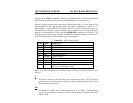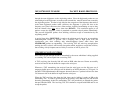
MFJ-1278B MULTI-MODE PACKET RADIO PROTOCOL
CHANNEL USE AND TIMING FUNCTIONS
The following discussions mention timing parameters which are set by various commands.
These timing functions are also discussed in Chapter 5.
An important part of any packet radio protocol is the means by which many stations make
efficient use of an RF channel, achieving maximum throughput with minimum interference.
The basis for this time domain multiplexing is Carrier-Sensed Multiple Access (CSMA) with
collision detection and collision avoidance.
CSMA means simply that (as every Amateur knows) no station will transmit if the frequency
is in use. The MFJ-1278B continually monitors for the presence of an audio data carrier on
frequency and transmits only if there is no carrier. (The RF carrier is not normally detected;
however, an input is available on the MFJ-1278B radio interface connectors to allow such an
input.) In order to make detection of a busy channel more reliable, the MFJ-1278B sends an
audio signal (continuous flags) any time the transmitter is keyed and a packet is not being
sent, as during the transmitter keyup delay (TXDELAY), or while a slow audio repeater is
being keyed (AXDELAY).
By itself, CSMA is not enough to insure a minimum, or even low, interference rate, due to the
likelihood of simultaneous keyup by two or more stations. This is where collision detection
and collision avoidance come in. The MFJ-1278B detects a collision by the absence of an
ACK from the station it is sending to. The receiving station does not acknowledge the frame
that suffered the collision, since either the FCS was incorrect or the packet was not heard.
There are other possible reasons for non-receipt of the packet, but the MFJ-1278B's response
is based on the assumption of a collision.
After transmitting a packet, the MFJ-1278B waits a "reasonable" length of time (FRACK)
for an acknowledgment. "Reasonable" is determined by the link activity, frame length,
whether the packet is being digipeated, and other time-related factors. If no ACK is received,
the packet must be re-sent. If the unACKed frame was lost due to a collision, the assumption
is that there is at least one other packet station out there that also lost a frame and will
probably have exactly the same criterion for deciding when to retry the transmission as this
station is using.
In order to avoid a second collision, the collision avoidance protocol calls for the stations
retrying transmissions to wait a random time interval after hearing the frequency become
clear before they key their transmitters. There must be enough different random wait times to
provide a reasonable chance of two or more stations selecting different values. The
difference between adjacent time values must be similar to the keyup time delay of typical
stations on the frequency. This is the time lapse after a station keys its transmitter before
other stations detect its presence on the channel, and is a function of the keying circuitry of


















